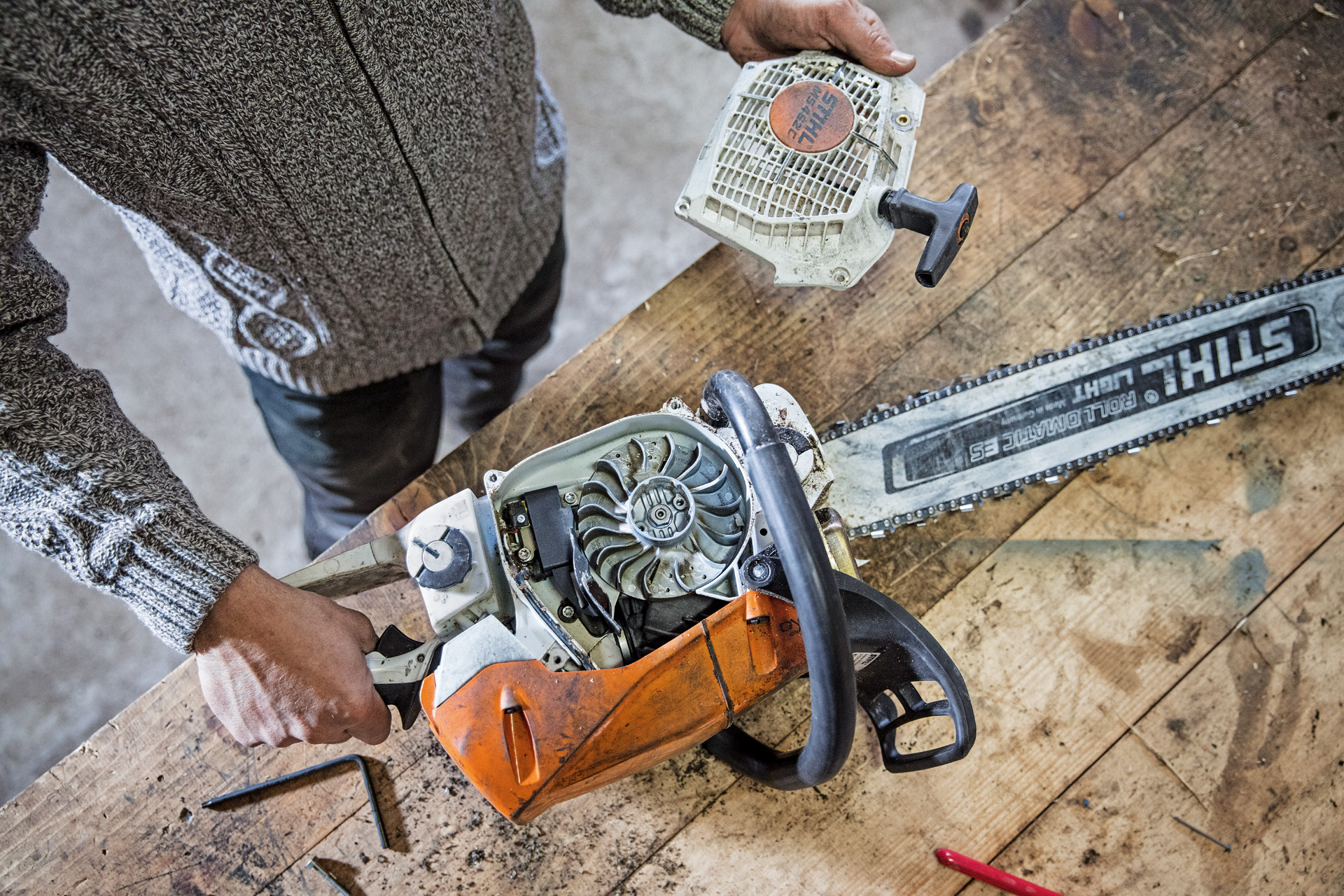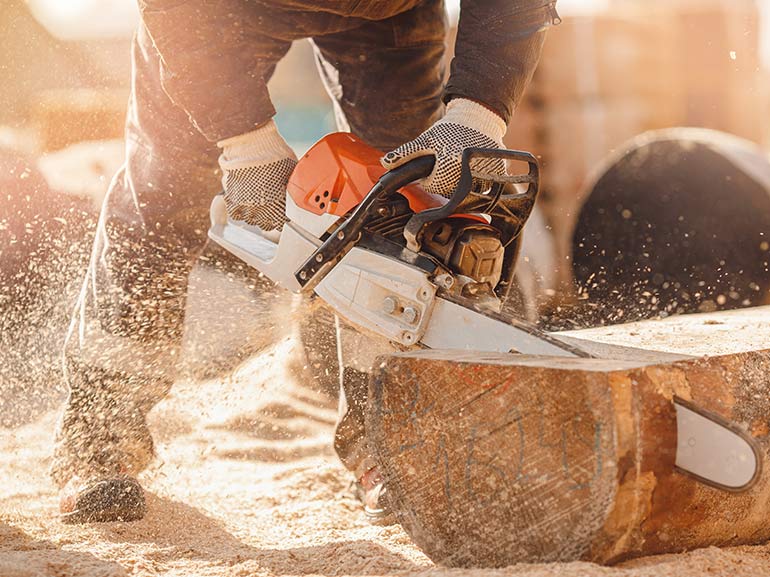
In the realm of power tools, chainsaws stand as undisputed champions, their sharp teeth and mighty engines conquering the wilderness with untamed efficiency. However, like any formidable force, chainsaws demand respect and proper care. Regular maintenance is not merely an option; it’s an essential ritual that ensures your chainsaw remains a loyal companion, not a temperamental beast.
The Daily Grind: Essential Checks for a Smooth Run
Before each use, a quick once-over is your best defense against unexpected breakdowns. Start by inspecting the chain, the lifeblood of your chainsaw. Ensure it’s sharp and tensioned correctly, a delicate balance that guarantees smooth cuts and minimizes strain on the engine. Next, check the oil level and lubricate the chain, providing the vital lubrication that keeps the chain from grinding against the bar, generating friction and premature wear.
Examine the bar, the guiding rail along which the chain dances. Check for wear and damage, as a worn-out bar can lead to chain derailment or kickback, a sudden and dangerous backward motion of the chainsaw. Next, turn your attention to the air filter, the breathing apparatus of your chainsaw. A clogged filter restricts airflow, starving the engine and causing performance issues. Clean it regularly to keep your chainsaw breathing easy.
Finally, give the starter cord and recoil spring a quick inspection. These unsung heroes ensure a smooth start, and any signs of wear or damage should prompt replacement to avoid frustrating no-starts.
Weekly Rituals: Deeper Dives for Optimal Performance
Once a week, dedicate some time to a more thorough examination of your chainsaw. Start by cleaning the spark plug, the ignition point that ignites the fuel-air mixture. A dirty spark plug can lead to hard starting and misfires. Check the gap between the electrodes and adjust if necessary.
Next, inspect the cooling fins, the aluminum fins that dissipate heat from the engine. If clogged with debris, they can’t do their job, causing the engine to overheat. Clean them gently with a brush or compressed air. Check the fuel lines for leaks, as fuel leaks not only waste precious fuel but also pose a fire hazard.
Tighten loose screws and bolts, ensuring that your chainsaw remains a cohesive unit. If the chain appears dull, don’t hesitate to sharpen it, as a sharp chain is crucial for optimal performance and safety.
Monthly Maintenance: A Deeper Dive into the Inner Workings
Once a month, delve deeper into the inner workings of your chainsaw. Start by cleaning the carburetor, the complex heart of the engine that mixes fuel and air. A dirty carburetor can cause a range of issues, from rough idling to stalling. Consult your owner’s manual for specific cleaning instructions.
Check the fuel filter, a small screen that prevents impurities from entering the carburetor. A clogged filter can starve the engine of fuel. Replace it if necessary. If the air filter hasn’t been replaced during your weekly checks, this is the time to do so.
Inspect the muffler, the device that reduces engine noise. A damaged muffler can not only be excessively loud but also indicate internal engine issues. Check the brake system, the safety feature that stops the chain in case of kickback. Ensure it’s functioning properly and replace any worn components.
Sharpening the Chain: The Art of a Razor-Sharp Edge
A sharp chain is the key to a smooth, efficient, and safe cutting experience. A dull chain increases the risk of kickback, strains the engine, and leads to premature wear. Sharpening your chain regularly is essential.
Invest in a quality chainsaw sharpening tool, such as a file, grinder, or filing guide. Each tool has its advantages, so choose the one that suits your preferences and skill level. Master the proper filing angles and techniques, ensuring that each tooth is sharpened evenly and to the correct depth.
Fuel and Oil: The Lifeblood of Your Chainsaw
The type of fuel and oil you use plays a crucial role in the performance and longevity of your chainsaw. Always use the fuel type recommended by your chainsaw manufacturer. Mixing fuel and oil in the proper ratio is essential; too much oil can clog the engine, while too little can lead to lubrication issues.
Choose the right bar and chain oil, considering the viscosity grade recommended by the manufacturer and the climate and cutting conditions you’ll be facing. Check the oil level regularly and top up as needed.
Safety First: Essential Precautions for a Hazard-Free Experience
Chainsaws are powerful tools that demand respect. Always work in a safe environment, clearing the work area of debris and obstacles that could cause you to stumble or lose control. Wear appropriate personal protective equipment (PPE), including safety glasses, gloves, ear protection, and sturdy boots.
Maintain a safe distance from others and structures to avoid accidental injuries or property damage. When handling the chainsaw, carry it properly, with the chain pointed away from you and your body. Start and stop the chainsaw in a safe manner, following the manufacturer’s instructions. Finally, develop proper cutting techniques to maximize efficiency and minimize risk.
Storing Your Chainsaw: A Secure Haven for Your Powerhouse
Once your work is done, don’t simply abandon your chainsaw. Before storing it, clean the exterior to remove debris that could attract moisture or pests. Store the chainsaw in a dry, well-ventilated area, protected from extreme temperatures and direct sunlight. If storing for an extended period, drain the fuel and oil to prevent gumming and clogging in the carburetor and fuel lines.
Troubleshooting Common Problems: When Your Chainsaw Coughs
Even with the best maintenance, your chainsaw might encounter hiccups. Common problems include hard starting, poor performance, excessive smoke, oil leaks, and chain skipping or breaking. Don’t panic! Familiarize yourself with these issues and their potential causes. Refer to your chainsaw’s owner’s manual for specific troubleshooting steps and solutions.
For more complex problems, consider consulting a qualified chainsaw technician. Their expertise can diagnose and fix issues beyond your comfort level, ensuring your chainsaw is back in top shape in no time.
Conclusion: The Rewards of a Well-Maintained Chainsaw
Regular chainsaw maintenance might seem like a chore, but the rewards are undeniable. A well-maintained chainsaw is a reliable and efficient tool, a loyal partner that tackles any cutting task with ease. Proper maintenance extends the life of your chainsaw, saving you money on repairs and replacements in the long run.
Most importantly, investing in maintenance prioritizes safety. A well-maintained chainsaw minimizes the risk of kickback and other accidents, allowing you to focus on the job at hand with confidence. Remember, a little care goes a long way. By incorporating these practices into your routine, you can transform your chainsaw from a potentially dangerous tool into a dependable and enjoyable companion, ready to conquer any cutting challenge.